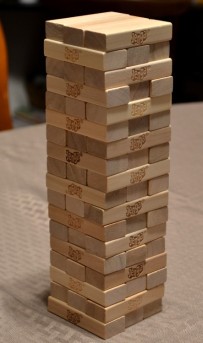Homework4W15
Contents |
Jenga Simulator
This project is designed for use with either the Razer Hydra or the zSpace.
The Immersive Visualization Laboratory at the Qualcomm Institute made 3 zSpaces with Windows PCs available for the project. They will need to be time shared between the groups that use them.
The Razer Hydras will be distributed in class on Tuesday, February 17th.
There will be a homework discussion on Wednesday, February 18th at 4pm in CSE lab 220.
Jenga is a popular game in which players take turns removing one block at a time from a tower constructed of 54 blocks. Each block removed is then balanced on top of the tower, creating a progressively taller but less stable structure. The player who successfully removes and places the last block wins.

|

|
| Starting configuration | Mid-game configuration |
Devices
There is a Piazza poll for which device you would prefer to use. There are only a limited number of Hydras as well as zSpaces available - hopefully we can agree on a device distribution. Please fill out the poll by Monday evening (Feb 16th) so that we can hand out the Hydras on Tuesday.
Here are some pros and cons for each device to help your decision:
Hydra:
+ Teams can take it home with them. + Two hand-held controllers allow for 2-handed interaction. + The Hydra is a popular gaming controller which will soon be succeeded by the Sixense STEM system. - No head tracking. - The tracking of the Hydra controllers is quite accurate but not as accurate as the zSpace stylus (it is electro-magnetic).
zSpace:
+ Excellent high definition stereo display. + Very accurate optical tracking. + Precise head tracking. + A very accurate stylus is the controller. It has three buttons on it. + zSpace computers have the free version of Unity installed. + The zSpace is a professional VR display used in industrial, medical and educational environments throughout the world. - Teams need to go to the instructor's laboratory to use it and time share the three systems.
The drivers for both devices, C++ API and Unity, are equally well implemented and documented and no issues are anticipated. Here are the driver links:
Hydra
To use the Hydra in Windows, you will need to first download and install the driver.
There is even an open-source Linux driver for the Hydra.
The Hydra SDK can be downloaded through Steam, but it's much easier to download it by its direct URL, which depends on your OS:
If you use Unity you will need the Unity plugin for the Hydra. Note that we did not test this so we would appreciate comments on your experience with it on Piazza. Some people say that you need Unity Pro to make it work - keep in mind that there is a Unity Pro 30 day trial available, and our final projects are due on March 19th, so if you hold off on the installation until February 17th or 18th you can use it for both this and the final project, should you so choose.
For instructions on how to get the Unity plugin to work look here.
zSpace
The zSpace drivers and the SDK are already installed on the zSpace developer workstations, along with Visual Studio and Unity.
We installed this Unity plugin. Note that, just as with the Hydra, we have not tested the Unity installation and rely on your pointers to fix any problems there might be.